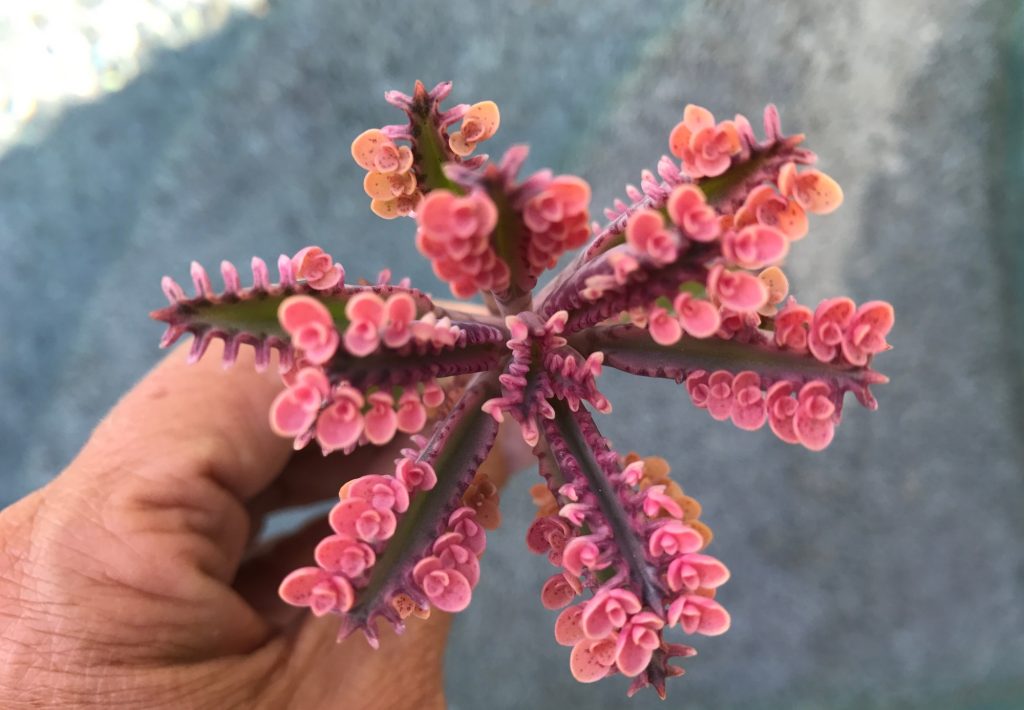The Mother of thousands plant is every inch a unique and attractive houseplant. Their foliage design and appearance are a total deviation from the appearance of regular houseplants. Some varieties have compact-sized leaves with tiny rose-like flowers at the tip of their leavers.
Some grow as stalks with a beautifully marked foliage surface. Any of the Mother of Thousand varieties is a perfect choice for both indoor and outdoor propagation. However, only the Mother of thousands of plants propagate outdoors can produce flowers.
This popular houseplant is a good match for a creatively detailed interior decoration theme. For a complementary effect on the appearance of your environment, you would need to grow them in proper growing conditions, alongside placing them in attractive containers and positioning them in inconspicuous locations.
Easy propagation and low maintenance are some beginner-friendly features of the Mother of thousand varieties. All you need to create a proper growing condition for your plant is organic soil, moderate watering, proper lighting and temperature, periodic fertilization, and a pest-free environment.
Just for you, we have provided the most striking Mother of Thousand plants to propagate. You would also find tips that would aid your propagation experience.
Mother Of Thousands Plant Profile And Basic Information
Getting acquainted with your Mother of Thousand plant is a perfect way of kick-starting your propagation journey. This plant profile offers you that.
| Botanical name | Kalanchoe Daigremontiana |
| Origin | Madagascar |
| Light | Bright indirect light |
| Watering | Moderate watering |
| Temperature | 60°F-75°F |
| Toxicity | Toxic to pets and humans |
| Propagation Style | Indoor and Outdoor propagation |
| Food | Balanced Granular Fertilizer |
| Humidity | Low humidity |
| Foliage color | Green and White |
| Flower Color | Red |
| Susceptible Plant Issues | Root rot, Wilting leaves, Sparse growth, and Pest Infestations |
| Susceptible Pest infestations | Scale insects, Beetles, Aphids, and Mealy Bugs |
These care tips would you guide you before and during your propagation journey.
- Choose a location with proper soil mix, preferably organic/loamy soil.
- Ensure the location chosen would enable the plant to receive sufficient sunlight whether indoors or outdoors.
- Select a well-drilled pot; you can use a ceramic or plastic pot. This enables proper drainage of water that would prevent overwatering. Overwatering is the leading cause of root rot. Avoid using an aluminum pot.
- Ensure the temperature is suitable for the perfect growing condition. A temperature gauge would come in handy to determine this. Low humidity should also be maintained. This can be achieved by using humidifiers and misting the leaves of your Mother of thousand varieties regularly.
- Select an attractive container so your Mother of thousands plant can complement the outlook of your home
- Be creative with your plant placement. Make use of beautiful plant stands, hangers, and baskets that would suit the theme of the environment.
- Apply balanced fertilizer during their growing season periodically. Avoid over-fertilization as it could lead to plant issues such as yellow leaves.
- Before creating a watering schedule for your plant, study the climate of your environment alongside the season of the environment you reside in. All these factors would determine the watering schedule of your plant.
- Ensure the plant never dries before watering. Avoid overwatering. In cases of overwatering, stay off watering till the plant recovers. If root rot hos occurred, repot the plant to give the plant a fresh start.
- Keep your kids and pets away from your Mother of Thousand varieties. They are toxic plants. In cases of ingestion. Contact a doctor immediately.
Mother Of Thousands Varieties: 6 Varieties To Propagate Today
These are the most popular Mother of Thousand plants to propagate today.
1. Kalanchoe Daigremontiana
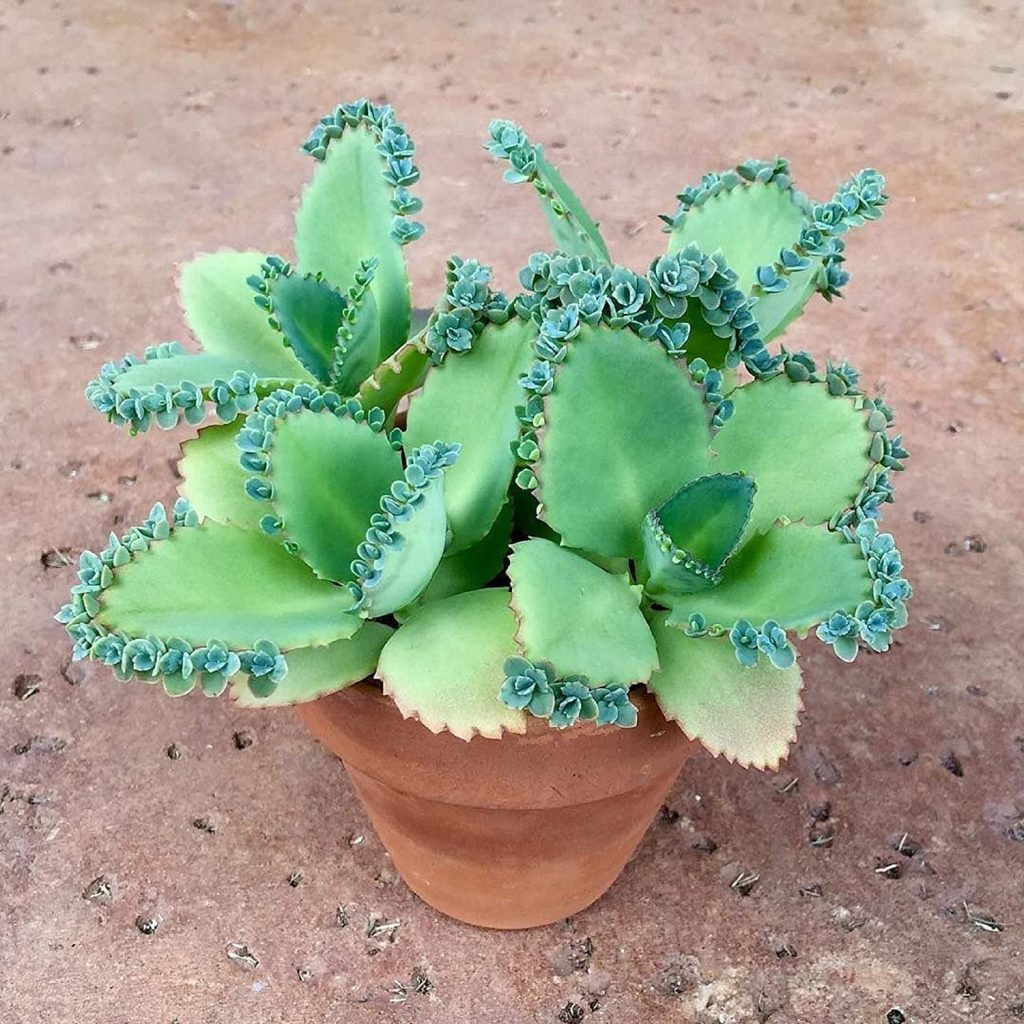
Also referred to as Devil’s Backbone, the Kalanchoe Daigremontiana is widely propagated for its foliage design and color. Their triangular leaves have brownish-black freckles. In addition, this variety has tiny purple roses at the edge of their leaves.
The Brownish black freckles can also be spotted on the underside of the plant. This stunning plant is can be propagated as an indoor and outdoor houseplant.
When propagated indoors, this variety does not the purple flowers it is known for. This is attributed to the fact that the lighting received indoors is not sufficient for the plant to grow flowers. the drought-tolerant plant is easy to propagate and care for only they have a slow growth rate.
The Kalanchoe Daigremontiana takes about 5 years to fully develop, so growers are advised to be patient. You are encouraged to use fertilizers to boost their growth, although this must be done with precautions and in moderation.
Low maintenance plants like the Kalanchoe Daigremontiana requires organic soil, regular watering, appropriate temperate condition, periodic fertilization, proper lighting, and a pest-free environment to enable proper growth. This variety becomes susceptible to pests when grown in an ungroomed environment.
Ensure their environment is kept neat to prevent pest infestations. Growers are encouraged to regularly mist their Kalanchoe daigremontiana.
2. Kalanchoe Tubliflora
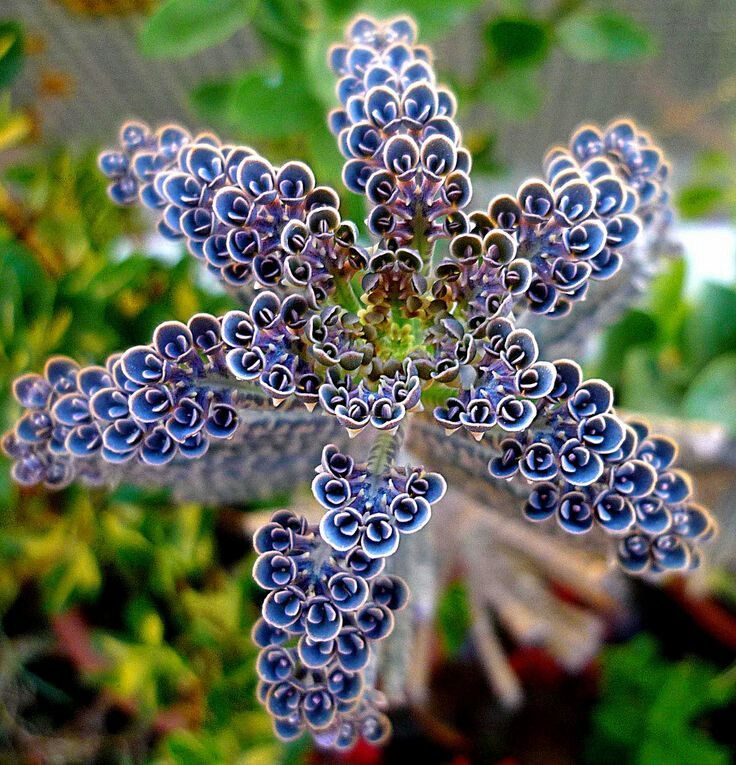
The Kalanchoe Tubliflora is one unique variety that is deeply appreciated for its unusual foliage design. Their foliage color is green with white polka dots on the leaves. In addition, they have circular pellets at the top of the plant. Also referred to as the Chandelier plant, the Kalanchoe Tubliflora is amongst the low-budget houseplants to propagate.
Growers with busy schedules are quick to pick this variety due to its drought tolerance and resistance to uncomfortable growth conditions. They should however not be neglected for a long period. The Kalanchoe Tubliflora thrives when exposed to proper lighting and appropriate temperature.
Before deciding to propagate this variety, ensure you select a location indoors and outdoors as you desire, where this plant would receive sufficient sunlight. Their growth is inhibited when growing in a poorly lit environment. For humidity and temperature, this variety prefers warm temperature and low humidity.
They thrive in temperatures between 60°F-75°F. To improve humidity for your Kalanchoe Tubliflora, regularly mist the plant or use humidifiers. For those grown outdoors, grow them amidst other plants but with proper spacing. The humidity level of the environment would be increased using this technique.
You can increase their attractiveness in your home by placing them in areas they could be displayed beautifully. Ceiling hangers, hanging shelves, and dangle baskets are good ideas for you. You can make use of beautiful plant stands especially in your living room or workstation.
3. Kalanchoe Fedtschenkoi
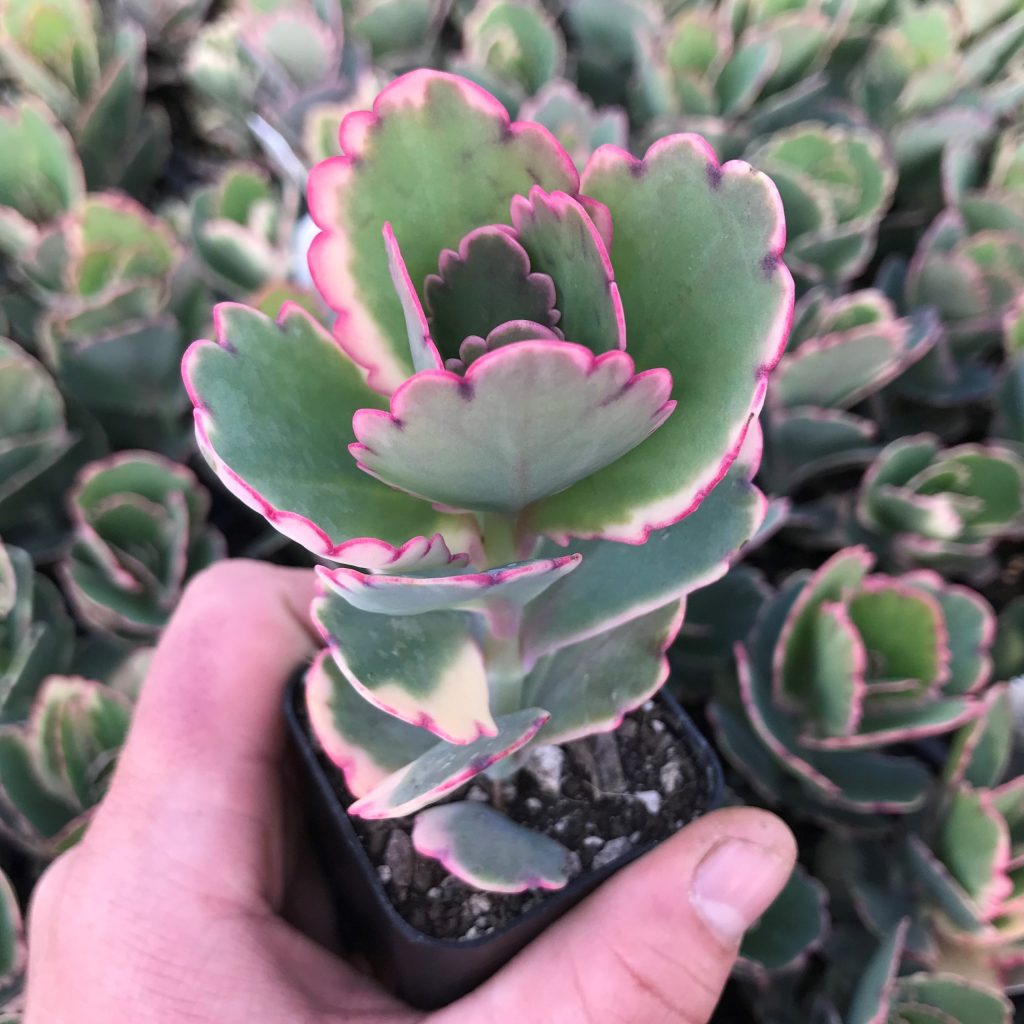
To most, the Kalanchoe Fedtschenkoi is regarded as one of the most attractive mothers of thousand varieties. Due to their foliage design and color, the Kalanchoe Fedtschenkoi is arguably one of the most propagated house and garden plants around the world.
They can be propagated through the stem cutting method. They produce bright red flowers during their bloom season.
The compact-sized pant grows in layers making them an attractive lot to be added to the interior design of a home. They are most beautiful during their blooming season. This plant is not only affordable, easy to propagate and care for but is also drought tolerant.
The Kalanchoe Fedtschenkoi is widely propagated as both an indoor houseplant and a gardening plant. They are beginner-friendly so beginners can find their way around the propagation process without any major hitch. They thrive in temperatures between 65°F-75°F.
They are prone to Aphids, Mealybugs. and Spider mites. Due to their attractive foliage, they can be kept anywhere around the home so far they can receive daily proper care and attention.
Their attractive foliage appearance can be enhanced by potting them in well-drilled attractive containers. Misting their leave is important is keeping the Kalanchoe Fedtschenkoi neat and refreshed.
4. Kalanchoe Gastonis Bonnierirs
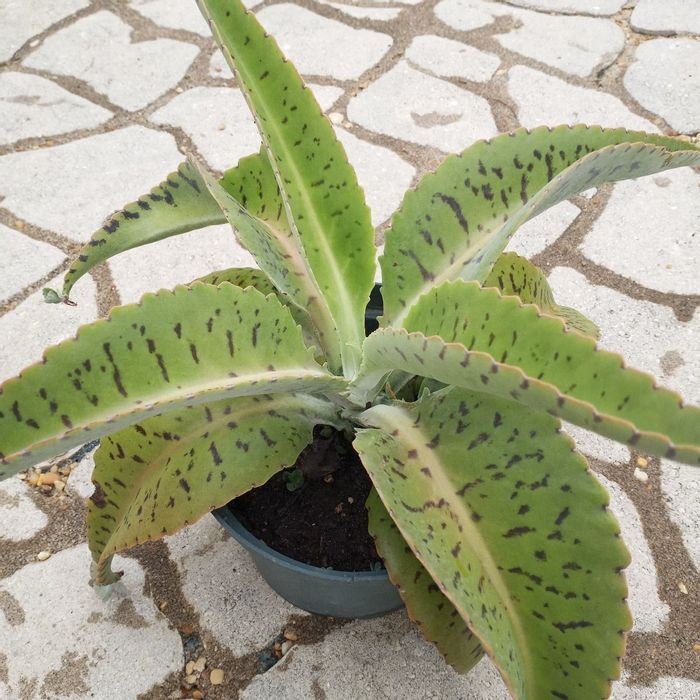
This variety also has a striking foliage appearance. Like the Kalanchoe Daigremontiana, the Kalanchoe Gastonis also has brownish splotches on their long triangular leaves. they are differentiated by the flowers they produce during their bloom season.
The Kalanchoe Gastonis produces green medium-sized flowers at the tip of their leaves.
They tend to grow large leaves, so growers must choose a suitable container that would match the size of the plant to prevent a cramped space. They have their origin in Madagascar. The Kalanchoe Gastonis thrives in temperatures between 60 °F-75 °F.
This variety is also popular, so it can be purchased from nurseries or plant stores. In cases where you purchase this plant from a different region, ensure you allow the plant to adjust to your environment. this helps prevent transplant shock. During this period, avoid fertilizing the plant as its roots may be tender.
After transplanting them, growers are expected to devote adequate time to tend to their Kalanchoe Gastonis. This stage determines if you would have a thriving plant. A hitch-free propagation is guaranteed when you provide organic soil, proper watering, temperature, and lighting for the plant.
When grown indoors, ensure the plant is placed in a well-lit environment. Make use of bright bulbs to improve the lighting condition of your plant.
5. Kalanchoe Houghtonii
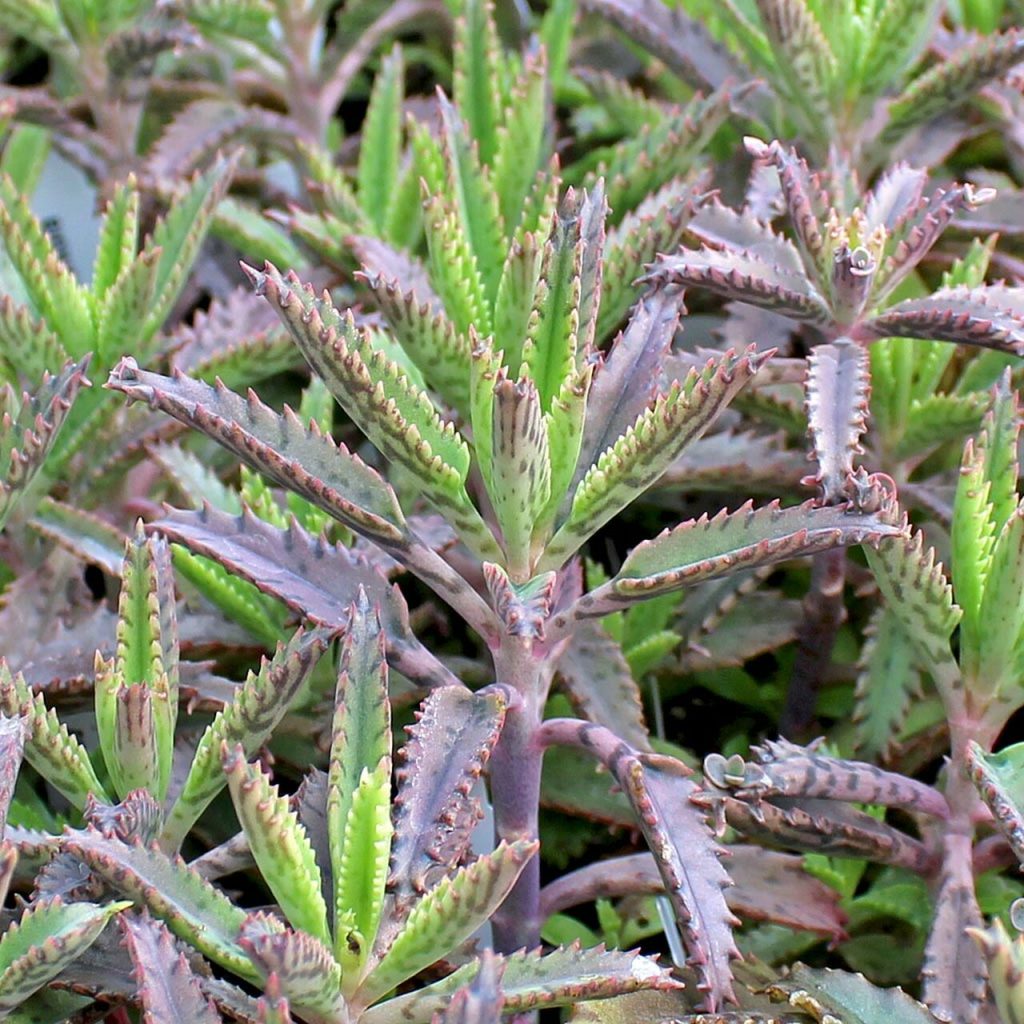
The Kalanchoe Houghtonii is a low-maintenance species propagated for its easy propagation. This unique variety has an enchanting foliage design marked with tiny flowers around their leaves’ tip.
For foliage color, the Kalanchoe Houghtonii is a mix of green and interestingly, this variety is a hybrid of Kalanchoe Daigremontiana and Kalanchoe Delagoensis. They have their origin in the United States.
They can grow up to 30 inches in height. During their bloom time, they produce a range of colorful flowers, from red, orange to yellow-pink. They thrive in temperatures between 65 °F-75 °F. This variety can be propagated indoors and outdoors.
Growers must be cautious about the lighting condition of this plant. The Kalanchoe Houghtonii must not be placed in a poorly lit environment. Poorly lit environments could mean exposure to low light or intense sunlight. Intense sunlight is always associated with Kalanchoe Hughtonii grown outdoors.
This is the reason growers are advised to provide for their plants. This helps reduce their exposure to direct sunlight. The appropriate lighting condition for your plant is bright indirect sunlight. Asides from this, watering is another factor that must be considered. You are expected to water them thoroughly, periodically.
Proper watering enables the soil to provide the necessary nutrients needed for a thriving plant. When deprived for a long period, the Kalanchoe Houghtonii would start to lose its brilliant foliage vigor and color.
6. Kalanchoe Pinnata
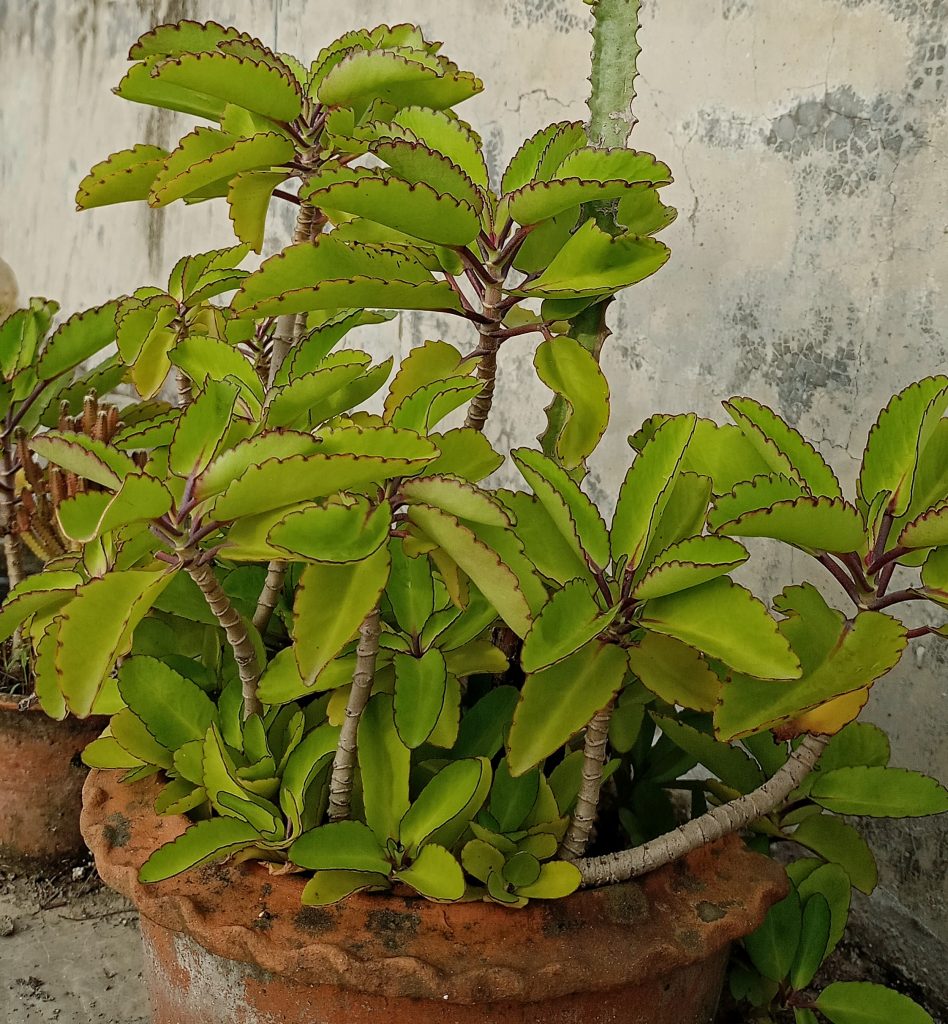
Also referred to as Air plant, Miracle leaf, and Goethe plant. For foliage appearance, this Mother of Thousand variety is a green oval-shaped plant with cropped edges. Their prominent foliage color is green. They have their origin in Madagascar. Under proper growing conditions, they can grow up to 39 inches tall.
Unlike other varieties, this variety is mostly propagated as an outdoor plant, but you can still grow them indoors.
Rather than stems, they have sturdy stalks that can withstand rafts meaning they can be positioned in a location within your environment. after considering how to create and maintain a proper growing condition for your plant, device means to keep your kids and pets away from your Kalanchoe Pinnata because they are toxic.
You could place the plant above your pets’ and kids’ reach. Hanging baskets and ceilings hangers would come in handy. Ensure the container used for potting is well drilled and matches the size of the plant. Do not make use of undersized or oversized containers. This can inhibit their growth.
After providing all the growth requirements for the plant, growers are advised not to neglect this plant. In addition, growers are encouraged to regularly check for signs of change in foliage appearance. This is the fastest way to detect a plant problem. Early detection can save your Kalanchoe Pinnata.
Final Note
The Mother of Thousand species is a popular house and garden plant due to its easy propagation and low maintenance.
Being drought tolerant and resistant to improper growing conditions longer than other plants contributes to the reason this plant is highly sought by houseplant growers and interior decor enthusiastic.
This beginner-friendly plant is a good choice, any day. After ticking all the boxes on creating the perfect growing environment for your Mother of Thousand plant, take the bold step of ordering the plant from a nursery or credible online plant store.
Discover more rare and common plant varieties:
